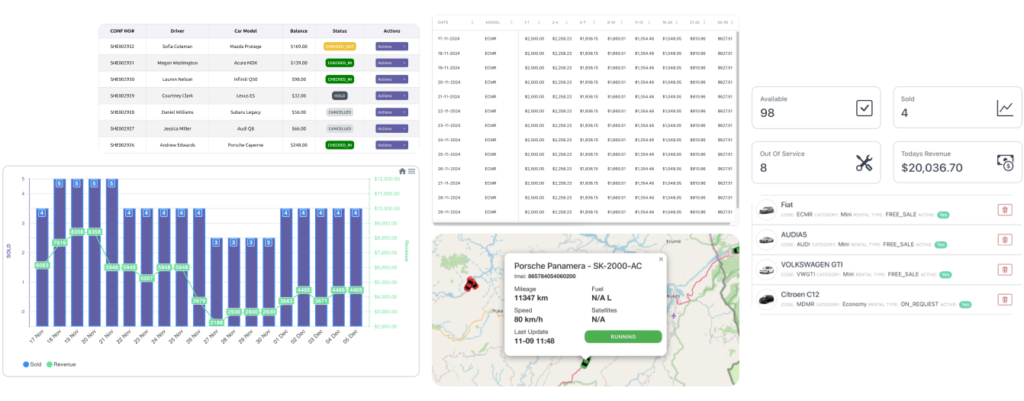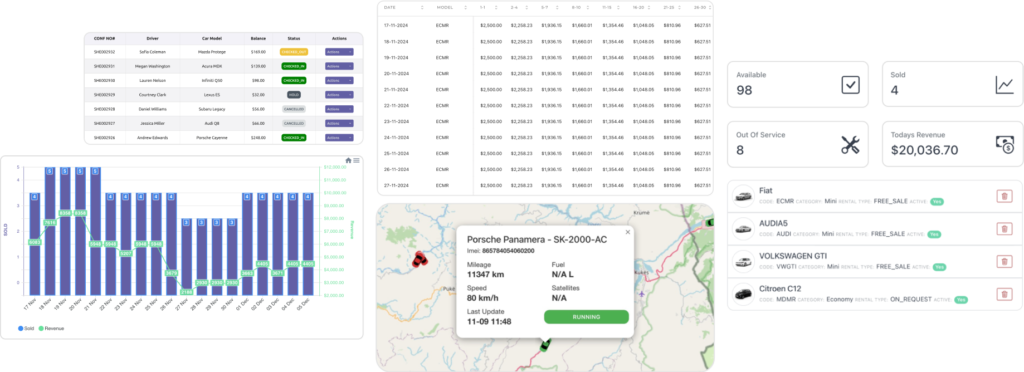In the highly competitive car rental industry, efficiency and customer satisfaction are paramount. Fleeton provides the tools and expertise to guide you every step of the way.
With the right car hire booking software, businesses can streamline operations, enhance customer experiences, and ultimately boost revenue.
This article explores the significance of booking software, reviews some of the top solutions on the market, and guides on selecting and implementing the right software for your business needs.
Understanding Car Hire Booking Software
Car hire booking software is designed to help with the management of rental car reservations, from customer inquiries to vehicle returns.
This software typically integrates various functionalities that assist rental agencies in optimizing their operations.
The evolution of technology has made it possible for car rental companies to automate numerous processes, reducing manual tasks and errors.
The result is a significant improvement in service delivery and operational efficiency. With the rise of mobile technology, many car hire booking systems now offer mobile apps, allowing customers to make reservations, manage bookings, and even unlock vehicles directly from their smartphones. This level of convenience not only enhances the customer experience but also attracts a tech-savvy clientele that values efficiency and ease of access.
The Role of Booking Software in Car Rental Business
The primary role of booking software is to manage the entire rental process efficiently. This includes handling online reservations, tracking vehicle availability, managing billing, and much more.
These software systems often provide a user-friendly interface for both customers and staff.
Additionally, many platforms now include features such as real-time inventory management, which ensures that rental agencies can quickly respond to customer demands and minimize the risk of overbooking.
Additionally, booking software offers analytics tools that help companies track important metrics such as utilization rates, customer preferences, and revenue trends.
By leveraging this data, businesses can make informed decisions that drive growth. For example, understanding peak rental times can help agencies optimize their fleet size and pricing strategies, ensuring they remain competitive in a crowded marketplace.
Furthermore, customer feedback mechanisms integrated into these systems allow agencies to continually refine their services based on real-time insights, fostering a culture of continuous improvement.
Key Features to Look for in Car Hire Booking Software
When evaluating car hire booking software, it’s essential to consider several key features:
- User-Friendly Interface: An intuitive interface can make it easier for both customers and staff to navigate the system effectively.
- Reservation Management: The ability to handle bookings, cancellations, and modifications seamlessly is crucial.
- Payment Processing: Secure and versatile payment processing options will enhance the customer experience.
- Reporting and Analytics: Robust reporting tools enable businesses to assess performance and implement strategic changes.
- Integrations: Compatibility with other tools such as CRM systems, accounting software, and marketing platforms is highly beneficial.
In addition to these features, consider the importance of customer support and training resources offered by the software provider.
A responsive support team can make a significant difference in resolving issues quickly, while comprehensive training materials can help staff become proficient in using the system.
Furthermore, look for software that allows for customization, as different rental agencies may have unique operational needs that require tailored solutions.
This flexibility can be a game-changer, enabling businesses to adapt their software to fit their specific workflows and customer interactions.
BOOK NOW

How to Choose the Right Booking Software for Your Business
With many options available, selecting the right booking software requires careful consideration and analysis. Here are some guiding factors to help you make the best choice for your organization.
Assessing Your Business Needs
The first step in choosing a software solution is to assess the unique needs of your business. Consider factors such as the size of your fleet, the number of rental locations, and the diversity of your customer base.
A thorough understanding of your operational needs will help you determine which features are essential and which software solutions align best with your objectives.
For instance, if your business caters to a diverse clientele, you might require software that supports multiple languages and currencies, enhancing the user experience for international customers.
Additionally, consider how your business might evolve in the future; opting for scalable solutions can save you from the hassle of switching systems as your operations grow.
Comparing Different Software Solutions
Once you have identified your needs, the next step is to compare different software solutions. Look at user reviews, feature lists, and pricing structures.
Demo presentations or trial periods can also provide invaluable insights. These allow you to experience firsthand how the software functions and how it can be beneficial for your business.
During these trials, pay attention to the user interface and overall ease of use; a complex system may lead to frustration among staff and customers alike.
Furthermore, consider the level of customer support offered by the software provider. A responsive support team can be crucial in resolving issues quickly and ensuring that your operations run smoothly.
Considering Budget and ROI
Budget considerations are critical when selecting booking software. Evaluate not only the upfront costs but also the long-term return on investment (ROI). Assess how much efficiency and time savings the software can generate versus its cost.
Ultimately, a more expensive option that enhances productivity and customer satisfaction may prove more beneficial in the long run than a cheaper alternative with limited features.
Additionally, consider hidden costs such as maintenance fees, training expenses, and potential upgrade costs.
A comprehensive financial analysis will help you make an informed decision, ensuring that the software you choose not only fits within your budget but also supports your business goals effectively.
By taking a holistic approach to budgeting, you can better understand the total cost of ownership and make a choice that aligns with your financial strategy.
BOOK NOW

Implementing Your Chosen Car Hire Booking Software
After selecting the appropriate booking software, you will need to implement it effectively to maximize its benefits. This often involves a few key steps.
Preparing Your Business for Software Integration
Preparing your business for the integration of new software is essential to ensure a smooth transition. This may involve updating your current processes, ensuring data compatibility, and developing a timeline for implementation.
Engaging with stakeholders early in the process will help ensure buy-in and assist in identifying potential challenges before they arise.
Additionally, conducting a thorough assessment of your existing workflows can help pinpoint areas that may require adjustment or enhancement to fully leverage the capabilities of the new software.
It’s also wise to consider the technological infrastructure of your business. Upgrading hardware or internet connectivity might be necessary to support the new software efficiently.
This proactive approach will not only facilitate a seamless integration but also prepare your team for the changes ahead.
Training Staff on New Software Use
Once the software is set up, staff training is crucial. All employees who will interact with the software need to be adequately trained to avoid confusion and errors.
Consider hosting training sessions, providing user manuals, and implementing support structures to help staff acclimate to the new system effectively.
Incorporating hands-on training and real-life scenarios can enhance understanding and retention of the software’s features.
Furthermore, establishing a mentorship program where more experienced staff can assist newer employees can foster a collaborative learning environment.
Encouraging feedback during the training process can also be beneficial. This allows you to identify any gaps in understanding and address them promptly, ensuring that all team members feel confident in using the software from day one.
Evaluating Software Performance and Making Adjustments
After implementation, it’s important to continuously evaluate the software’s performance. This involves monitoring usage, gathering user feedback, and analyzing key performance indicators.
Be open to making adjustments to either the software or your utilization processes. Continuous improvement can lead to enhanced efficiency and increased profit margins over time.
Regularly scheduled check-ins with your team can help maintain open lines of communication and encourage ongoing dialogue about the software’s performance and any issues that may arise.
Additionally, leveraging analytics tools integrated within the software can provide valuable insights into customer behavior and booking trends.
This data can inform strategic decisions, allowing you to adapt your services to better meet customer needs and preferences, ultimately driving growth and customer satisfaction.
Ready to take the next step? Book a meeting with our team today to discuss your fleet management needs. Let's find the best solution for your business!
BOOK NOW


